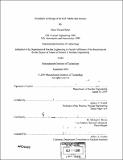| dc.contributor.advisor | Andrew C. Kadak. | en_US |
| dc.contributor.author | Berte, Marc Vincent, 1977- | en_US |
| dc.contributor.other | Massachusetts Institute of Technology. Dept. of Nuclear Engineering. | en_US |
| dc.date.accessioned | 2006-07-31T15:19:04Z | |
| dc.date.available | 2006-07-31T15:19:04Z | |
| dc.date.copyright | 2004 | en_US |
| dc.date.issued | 2004 | en_US |
| dc.identifier.uri | http://hdl.handle.net/1721.1/33637 | |
| dc.description | Thesis (S.M.)--Massachusetts Institute of Technology, Dept. of Nuclear Engineering, 2004. | en_US |
| dc.description | Includes bibliographical references (p. 110-113). | en_US |
| dc.description.abstract | The future of new nuclear power plant construction will depend in large part on the ability of designers to reduce capital, operations, and maintenance costs. One of the methods proposed, is to enhance the modularity of the designs in which the basic plant is broken down into modules, each of which is built offsite at a "factory", transported to the plant site, and assembled into a working plant using a minimum amount of labor and tooling. The value of this approach is that it improves overall quality, reduces site field work and rework, and speeds the construction of the plant. This approach also takes advantage of economies of mass-production, rather than relying on economy of scale to reduce costs. The ability to remove and replace modules for repair and maintenance also leads to reduced costs and downtime. Past work at MIT has resulted in a reference design that takes into account modularity. Based on this reference cycle design, a detailed analysis and modularity design of a power producing plant was performed. This design takes into account the goals for the modularity and construction approach. | en_US |
| dc.description.abstract | (cont.) The plant takes the factory approach to its logical conclusion, resulting in a "virtual factory" where each major component is integrated into a modular space-frame by its manufacturer. Each module is designed to be transported by truck (although, if the necessary infrastructure is available the modules could be transported at potentially lower cost by rail or barge) to the construction site. The plant site itself requires only simple excavation and the plant containment building is a simple, reinforced poured concrete structure. Assembly of the plant is simple by comparison to conventional facilities as the modularity approach requires that each space-frame module be stacked together, pipe flanged bolted together, a self-test performed, and the plant started. In order to make this assembly method possible a pressure-backed insulation system was designed. This insulation system reduces the temperature of the pressure boundary, enabling the use of lower-cost alloys for system construction. The metallic liner and insulation layer also reduce the temperature swings of the piping and vessel walls, reducing thermal expansion loads that must be borne by the structure of the system. | en_US |
| dc.description.abstract | (cont. ) To enable flange-joints between component modules a scavenged flange design was created. This flange design enables redundant sealing of the pressure boundary, and also prevents Helium loss and contamination of the plant. This design also enables monitoring of the flange integrity. This design should enable the MIT pebble bed reactor to meet the cost, operations and maintenance goals of an advanced reactor. | en_US |
| dc.description.statementofresponsibility | by Marc Vincent Berte. | en_US |
| dc.format.extent | 113 p. | en_US |
| dc.format.extent | 10034595 bytes | |
| dc.format.extent | 10039322 bytes | |
| dc.format.mimetype | application/pdf | |
| dc.format.mimetype | application/pdf | |
| dc.language.iso | eng | en_US |
| dc.publisher | Massachusetts Institute of Technology | en_US |
| dc.rights | M.I.T. theses are protected by copyright. They may be viewed from this source for any purpose, but reproduction or distribution in any format is prohibited without written permission. See provided URL for inquiries about permission. | en_US |
| dc.rights.uri | http://dspace.mit.edu/handle/1721.1/7582 | |
| dc.subject | Nuclear Engineering. | en_US |
| dc.title | Modularity in design of the MIT Pebble Bed Reactor | en_US |
| dc.title.alternative | Modularity in design of the MIT PBR | en_US |
| dc.type | Thesis | en_US |
| dc.description.degree | S.M. | en_US |
| dc.contributor.department | Massachusetts Institute of Technology. Department of Nuclear Engineering | en_US |
| dc.contributor.department | Massachusetts Institute of Technology. Department of Nuclear Science and Engineering | |
| dc.identifier.oclc | 64393786 | en_US |
